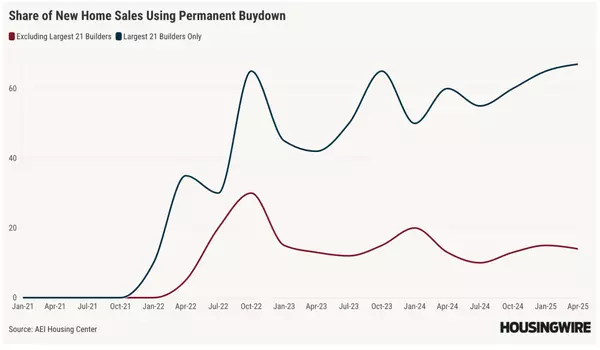November Demo Day: Dara Invoice by Sagent

Dara Invoice Dara Invoice streamlines invoice management between servicers and their default servicing partners. It automates the invoice-review process by applying investor guidelines and servicer-specific business rules, helping organizations improve efficiency, minimize errors, and accelerate pay
Read MoreNovember Demo Day: OneHomeowner by Cotality

OneHomeowner OneHomeowner makes long-term client connections easy. It’s an intuitive, branded platform that helps you be your client’s trusted home management resource before and after the sale. Deliver timely content, gain insights, and stay top of mind for years, strengthening your professional sp
Read MoreNovember Demo Day: Intelligent Quality Control by Blend

Intelligent Quality Control Blend’s AI-powered Intelligent Quality Control product enhances loan quality control, helping QC analysts detect issues more efficiently. It applies digitized underwriting guidelines to loan data and documents and provides step-by-step validation and reasoning, enabling t
Read MoreNovember Demo Day: DocMagic One

DocMagic One DocMagic One is a unified mortgage production platform that streamlines document preparation, automated compliance, and eSignature management in one place. Powered by AI and machine learning, it enhances seamless collaboration between lenders, notaries, settlement providers, and borrowe
Read MoreCentury 21 merger creates tri-state service net

Ohio-based Century 21 Excellence Realty — a regional brokerage with offices in Columbus, Cleveland and Akron — has merged with Realty Exchange, which operates four offices serving communities across Ohio, West Virginia and Kentucky. The combined firm will operate under the Century 21 Excellence Real
Read MoreNEXA Lending promotes Rana Mortensen to chief administrative officer

NEXA Lending announced another change to its C-suite on Tuesday, promoting Rana Mortensen to chief administrative officer. In her new role, Mortensen will oversee the company’s administrative operations across multiple departments — including facilities, human resources, people operations, corporate
Read MoreOpteon acquires Equity Valuation Partners, expands US presence

Opteon has acquired Equity Valuation Partners (EVP) as part of its efforts to expand operations and strengthen technology-driven property valuation services. The acquisition adds to Opteon’s growing U.S. presence — combining the company’s appraisal management platform with Equity Valuation Partners’
Read MoreKnock debuts new buy-before-you-sell bridge loan

Knock, a real estate technology company that helps homeowners buy before they sell, is launching a new loan product. On Tuesday, the company announced the debut of Knock Bridge Loan Plus. The new offering provides the same benefits as the company’s original bridge loan product. This includes its gu
Read MoreAivre launches UAD 3.6 compliant appraisal platform

Aivre has launched a new artificial intelligence (AI)-driven appraisal platform, becoming the first in the U.S. to complete the Uniform Appraisal Dataset (UAD) 3.6 verification process with Fannie Mae and Freddie Mac. UAD 3.6 calls for electronic submission of appraisals to align with the Mortgage I
Read MoreHouse bill calls for HOME housing program reforms

Despite the government shutdown, U.S. Reps. Mike Flood (R-Neb.) and Emanuel Cleaver (D-Mo.), leaders of the House Financial Services Subcommittee on Housing and Insurance, have introduced the HOME Reform Act of 2025 — a bill promising to streamline the HOME Investment Partnerships Program administer
Read MoreFHFA inspector general role vacant after reported ouster of Joe Allen

The inspector general position at the Federal Housing Finance Agency (FHFA) is currently vacant after the reported ouster of Joe Allen. Allen, who was appointed as acting inspector general in April 2025, also served as chief counsel for the Office of Inspector General (OIG). It remains unclear when
Read MoreBroker wants NAR membership lawsuit dismissal overturned

Luz de Amor Eytalis has filed a brief in support of the appeal she filed of the district court’s dismissal of her antitrust lawsuit against the National Association of Realtors (NAR), Paragon MLS Connect, Wichita Falls Association of Realtors and Texas Association of Realtors in August. In her brie
Read MoreColumbus Realtors, Rayse partner to highlight agent value

Columbus Realtors has partnered with Rayse — an agent value platform designed to help real estate professionals show their work and impact in real time. The collaboration gives the association’s 9,000-plus members complimentary access to Rayse through their member portal. “Our members work hard to d
Read MoreNewDay USA unveils VA loan option that removes closing costs

NewDay USA, a national mortgage lender that serves veterans, on Monday announced a new loan offering designed to help veterans and service members buy homes by addressing one of the biggest financial barriers — closing costs. The product, NewDay Home, allows qualifying borrowers with steady employme
Read MoreWhy is consistency the key to real estate success?

As you well know, there are so many classes on how to succeed in real estate — how to make the perfect phone call, how to master self-promo and marketing, how to door-knock without being awkward, how to write killer scripts, negotiate better offers or dominate social media. All of those are fine and
Read MoreWhat makes personal PR a game-changer for real estate agents?

For decades, real estate marketing revolved around the property—glossy images taken by professional photographers became the norm, followed by videography and aerial drone images, 3-D tours and compelling storytelling. While these remain essential to effective property marketing, the agent’s persona
Read MoreSun West files new lawsuit against FNB over reverse mortgage repurchases

Sun West Mortgage Co. (SWM) has filed a lawsuit against First National Bank of Pennsylvania (FNB) for failing to repurchase two reverse mortgages worth more than $850,000 from Fannie Mae, alleging a breach of a 2017 settlement agreement. The case involves reverse mortgages transferred from a bank a
Read MoreNEXA expands lawsuit against former employee, adds defendants

NEXA Lending is continuing its legal battle against former employee Kristine Wake and has expanded its lawsuit, alleging that Wake and others misappropriated trade secrets, violated contracts and attempted to recruit NEXA employees to a competitor. The original suit, filed in May 2025 in the U.S. Di
Read MoreMortgage spreads hit lowest level in years, keeping rates near 6%
The unsung hero of the housing market in 2025 has been the improvement in mortgage spreads, because without the spreads improving as much as they have, mortgage rates would not have gotten near 6% this year. I forecast that mortgage spreads should improve by 0.27%-0.41% this year, from a 2.54% avera
Read MoreTech Pulse: AI advances, big earnings and policy shifts

Welcome back to Tech Pulse — HousingWire‘s weekly series rounding up the latest in technology news, including tools, integrations and trends that impact mortgage and real estate. Here’s what happened this week: Zillow’s Follow Up Boss privacy policy changes spark industry debate Zillow‘s updated pri
Read More
Categories
Recent Posts










